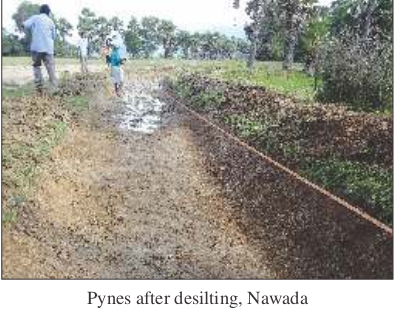Enhancing resilience through improvement in conveyance efficiency
Enhancing resilience through improvement in conveyance efficiency
Climate vulnerability
Drought / Flood
Existing practice
One of the reasons for gap between potential created and utilized under canal irrigation systems is the lack of maintenance of conveyance channels which became silted up. As a result, tail end villages do not get the intended irrigation water supplied and often the envisaged benefits cannot be realized. As part of NICRA interventions, emphasis was on clearing of conveyance channels for providing irrigation to target areas. In Bihar, the age old 'Aahar' and 'Pyne' systems were renovated at the local level, so that water could be made available to intended beneficiaries. Some of the case studies on this initiative are presented below.
Resilience practice / technology
'Aahar' in Majhilla village of Nawada district was filled with silt and was unable to store enough rainwater and recharge other wells in the village. As a result, the village suffered from acute water shortage both for human and livestock uses during summer. This also resulted in poor productivity of paddy, the major crop of this area which depends mostly on groundwater for irrigation. Renovation of Aahar (water reservoir) and construction of farm ponds were taken up in the village.
Similarly, NICRA village Matsyapuri in West Godavari district (Andhra Pradesh) receives an average annual rainfall of 1185 mm with frequent floods which submerge croplands resulting in crop failure. There are two irrigation channels, namely Mentepudi channel and VWS channel which are the major irrigation water source covering 640 ha (Mentepudi channel 400 ha and VWS channel 240 ha). Rice is the major crop cultivated in this village by 300 farmers. Over the years, these channels became nearly defunct due to silting and wild growth resulting in reduced capacity to supply irrigation water to tail end areas in the village. It also led to flooding of nearby fields during monsoon. Renovation and deepening of these two irrigation channels was taken up under NICRA project during 2012-13.
Impact of renovated irrigation channel
At Majhilla village of Nawada, prior to the project interventions, the village did not have any ponds. Old 'Aahar' was defunct. Rainwater harvesting increased by 20,000 m3 after renovation and excavation. This helped in providing protective irrigation in 24 ha during dry spells in kharif.
- Paddy productivity increased by 20.7%
- Groundwater level increased by one feet
- Drinking water for livestock was made available
At Matsyapuri village of West Godavari, as a result of this intervention, rice cultivation could be taken up by farmers in the tail end area. It also helped in efficient disposal of rainwater by avoiding flooding and submergence of crops at times of intense rainfall events. There was heavy rainfall in the first week of November 2012 due to 'Neelam' cyclone and excess flood water was disposed-off safely. This prevented submergence of fields adjacent to the canals. It was noticed that there was flood water only up to a height of 42 cm in command area under the deepened channels and there was no overflowing of flood water. In other untreated areas submergence was up to 122 cm height and the crop was completely submerged due to flood water. This resulted in avoiding yield loss to the extent of 41.3 q/ha with MTU-1061, 33.8 q/ha with BPT- 5204 and 26.3 q/ha with MTU-7029 in paddy areas under the renovated channels whereas the actual yield was only 15 q/ha in untreated areas that suffered submergence.




Source: Smart practices and Technologies for Climate Resilient Agriculture
ಕೊನೆಯ ಮಾರ್ಪಾಟು : 3/1/2020
This topic provides information about Community ta...
This topic provides information about Crop diversi...
This topic provides information about Drought tole...
This topic provides information about Check dams f...
